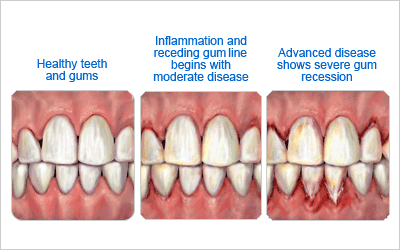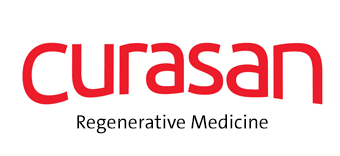
Periodontitis, or gum disease, is a common condition that can damage the soft tissue and bone that support the teeth. Left untreated, periodontal gum disease can lead to tooth loss. Fortunately for your patient, there are symptoms associated with the progression of this disease which if detected, can lead them to early treatment.
Gum disease is very common, according to the American Academy of Periodontology, which says that 47.2 percent of Americans aged 30 and over suffers from periodontitis.
Periodontal disease is a chronic inflammatory condition, which means gum inflammation persists for months or even years. Periodontitis is associated with other chronic inflammatory conditions, such as cardiovascular disease and diabetes.
How Periodontal Disease Develops
Gum disease starts when bacteria mixes with plaque, which is a clear sticky substance that covers the teeth. Plaque can get between the teeth and gums, giving bacteria a rich place to flourish. Plaque is relatively easy to remove with brushing and flossing.
In time, plaque can harden into tartar. Tartar cannot be removed by simply brushing and flossing; only professional dental cleaning can help. Plaque and tartar build up around the tooth. The body responds to the accumulation of plaque and tartar by launching an inflammatory response. In other words, the presence of plaque and tartar causes inflammation of the gums.
Chronic inflammation and damage from plaque and tartar can cause the gums to pull away from the teeth, creating pockets in the gums that are vulnerable to bacterial infections that can hasten tooth loss. These pockets can become quite deep. In fact, pockets can become so deep that they are difficult to clean.
Stages of Gum Disease
Gum disease is a chronic, progressive condition, which means it does not go away by itself and gets worse over time. There are three main stages of gum disease:
Gingivitis
Gingivitis is the earliest stage of gum disease, characterized by plaque buildup and inflammation of the gums. Toxins from the plaque can irritate the gums to cause inflammation. Bleeding may occur during brushing and flossing. Proper oral care, both at home and from a dental professional, can prevent gingivitis from advancing to the next stage.
Periodontitis
Periodontitis is the second stage of gum disease, characterized by damage to the supportive fibers and bone that hold teeth in place. Pockets may develop below the gum line, and these pockets may trap food and bacteria. Improved home care and professional dental care can save teeth at this stage.
Advanced periodontitis
Advanced periodontitis is the final stage of gum disease. At this point, damage to the bone and fibers holding teeth allow them to loosen or shift position. Loose teeth or poorly positioned teeth can change the bite, which can affect the ability to eat. Even aggressive care may not be able to save teeth at this stage.
Risk Factors for Developing Periodontal Gum Disease
The main cause of gum disease is plaque, but certain factors can increase your patient’s risk of developing periodontal disease.
Age
Older adults are more likely to have periodontal disease. In fact, more than 70 percent of adults age 65 and older have the condition, according to theAmerican Academy of Periodontology.
Smoking
Smokers have twice the risk of developing periodontal disease as compared with non-smokers, according to the Centers for Disease Control and Prevention (CDC). Smoking weakens the immune system, which makes it harder for the body to defend itself against gum infections.
Stress
Stress also weakens the immune system, making a person under stress more vulnerable to gum infections.
Genetics
Some people inherit a susceptibility to gum disease from their parents.
Medications
Oral contraceptives, certain heart medications, antidepressants, and other medications may increase the risk of gum disease. Medications that cause dry mouth can also increase the risk of periodontal disease.
Grinding or clenching your teeth
Grinding or clenching of the teeth puts a tremendous amount of pressure on the tissue that supports teeth; this pressure can speed up the destruction of those supportive tissues.
Poor nutrition, obesity
Like other body systems, the immune system relies on a steady supply of nutrients to perform at its best. Poor nutrition can interfere with the immune system’s ability to fight off infections in the gums and elsewhere in the body. Because it starts as an infection, gum disease can even worsen as the result of poor nutrition.
Obesity increases the risk of periodontal disease, according to research in which overweight participants were 4.2 percent more likely to have severe gum disease and obese participants were 5.9 percent more likely to have the condition than were participants of normal weight.
Other medical conditions
Medical conditions that interfere with the body’s inflammatory system can increase the risk of periodontal gum disease. These conditions include cardiovascular disease, diabetes, and rheumatoid arthritis.
Lifestyle and Home Remedies to Address the Warning Signs, Reduce Risk of Periodontal Disease
By maintaining good oral hygiene habits, the risk of periodontal disease can be reduced, or even stopped from getting worse. Preventative measures include brushing teeth at least twice a day and flossing once daily to remove food particles, plaque, and bacteria; brushing after meals and snacks also offers maximum protection. Patients can also use a soft toothbrush and replace it frequently. An electric toothbrush, which may be more effective at removing plaque, is worth the investment. Advise patients not to smoke or chew tobacco, and to get regular, professional dental cleanings.
Warning Signs of Periodontal Gum Disease
Healthy gums should be pale pink. They should also fit around the teeth snugly to prevent food particles and bacteria from getting in between the teeth and gums. Periodontitis is the medical terms that means “inflammation around the tooth,” so the main sign of periodontitis is puffiness and swelling around one or more teeth.
- Bright red, dusky red, or purplish-colored gums
- Swollen or puffy gums
- Gums that feel tender when touched
- Painful chewing or other pain in the mouth
- Gums that bleed easily while brushing, flossing, or chewing hard food
- Gums that are pulling away or receding from the teeth, which causes teeth to look longer than before
- Loose teeth
- Separating teeth
- Pockets of pus between gums and teeth
- Sores in the mouth
- Persistent bad breath
- A change in the way teeth fit together when a person bites down
What to do if Your Patient Notices Signs of Periodontal Gum Disease
If they notice any signs of periodontal disease, advise them to seek your professional attention. Only dental professionals can accurately diagnose periodontal gum disease.
Treatment for Periodontal Disease
The goal of treatment is to clean the pockets surrounding the teeth and prevent damage to the bone. Non-surgical treatments can address mild to moderate periodontal disease. Severe gum disease may require surgical treatments.
Nonsurgical treatments for periodontal gum disease
Scaling and root planing – types of careful dental cleaning of the root surfaces that remove plaque and tartar. Scaling is the removal of tartar from the surface of teeth, while root planing removes infected root structure and smoothens the root surfaces.
Antibiotics – to control bacterial infections.
Surgical treatments for periodontal gum disease
Pocket reduction – also known as flap surgery, this procedure involves tiny incisions that expose the roots for more effective scaling and root planing
Soft tissue grafts – the transplantation of healthy gum tissue to areas of receding gum line, with the intent of covering roots exposed by gum disease
Bone grafts – the transplantation of healthy bone or synthetic bone to areas where periodontitis has destroyed bone that holds teeth in place
Guided tissue regeneration – the placement of a biocompatible fabric between existing bone and teeth to prevent the unwanted growth of tissue in the healing area
Tissue stimulating proteins – the application of a gel to the tooth root; the gel contains proteins found in developing tooth enamel, so it promotes the growth of healthy bone and tissue
As a pioneer and global technology leader in the growing field of regenerative medicine, curasan specializes primarily on biomimetic bone grafting materials for dental, oral/maxillofacial, orthopedic, and spinal applications. We develop and manufacture biomaterials and medical devices in the field of bone and tissue regeneration, wound healing, and osteoarthritis therapy. We have a strong reputation on delivering outstanding customer service and providing top quality products around the globe. To learn more about our products and how to incorporate them into your business with our easy ordering process, we’d love to chat.
